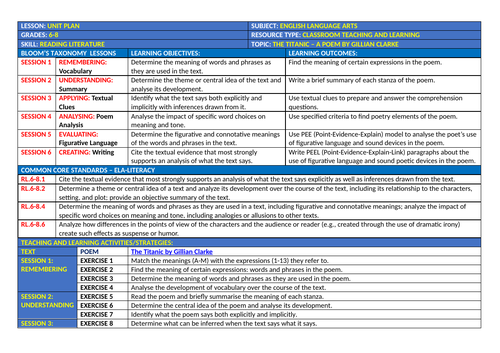

A unit plan on poetry comprehension with 6 sessions on teaching and learning of the poem, “The Titanic” by Gillian Clarke based on New Bloom’s Taxonomy.
This download includes:
POEM: The Titanic by Gillian Clarke
EXERCISE 1: Match the meanings (A-M) with the expressions (1-13) they refer to.
EXERCISE 2: Find the meaning of certain expressions: words and phrases in the poem.
EXERCISE 3: Determine the meaning of words and phrases as they are used in the poem.
EXERCISE 4: Analyse the development of vocabulary over the course of the text.
EXERCISE 5: Read the poem and briefly summarise the meaning of each stanza.
EXERCISE 6: Determine the central idea of the poem and analyse its development.
EXERCISE 7: Identify what the poem says both explicitly and implicitly.
EXERCISE 8: Determine what can be inferred when the text says what it says.
SCAFFOLDING NOTES 1: Common Comprehension Types
EXERCISE 9: Prepare your own comprehension question types with answers from the text.
EXERCISE 10: Use textual clues to answer the comprehension questions.
SCAFFOLDING NOTES 2: Poetry Elements Criteria
EXERCISE 11: Use the specified criteria to find poetry elements of the poem.
EXERCISE 12: Analyse the impact of specific word choices on meaning and tone.
EXERCISE 13: Answer the questions to check your understanding of poetry elements.
SCAFFOLDING NOTES 3: PEE (Point-Evidence-Explain) Model
EXERCISE 14: Use PEE (Point-Evidence-Explain) model to analyse the poet’s use of figurative language in the poem.
EXERCISE 15: Answer the questions to check your understanding of the figures of speech used in the poem.
EXERCISE 16: Answer the questions to check your understanding of the use of figurative language in the poem.
EXERCISE 17: Determine the meaning of words and phrases as they are used in the text, including figurative meanings.
EXERCISE 18: Use PEE (Point-Evidence-Explain) model to analyse the poet’s use of sound poetic devices.
EXERCISE 19: Answer the questions to check your understanding of the figures of speech used in the poem.
EXERCISE 20: Determine the connotative meanings of the words and phrases in the poem.
EXERCISE 21: Determine the meaning of words and phrases as they are used in the text, including connotative meanings.
SCAFFOLDING NOTES 4: PEEL (Point-Evidence-Explain-Link) Technique
EXERCISE 22: Write PEEL (Point-Evidence-Explain-Link) paragraphs about the use of figurative language in the poem.
EXERCISE 23: Write PEEL (Point-Evidence-Explain-Link) paragraphs about the use of sound poetic devices in the poem.
Get this resource as part of a bundle and save up to 50%
A bundle is a package of resources grouped together to teach a particular topic, or a series of lessons, in one place.
READING POETRY: BLOOM'S TAXONOMY-BASED UNIT LESSONS - BUNDLE
This bundle of 4 products (Unit Lesson Plans) is perfect for teaching Poetry Reading Comprehension. These no prep activities would be great for ELA lessons or ELA centers. Your students will love these self-grading exercises that are gamified for student engagement. After completing these lessons, the students will be able to: * Find the meaning of challenging words and expressions in the poem. * Identify the key ideas of the poem. * Use textual clues to answer the retrieval and inferential questions. * Analyse the poem to find its poetry elements – genre, message, tone, context, perspective, point of view, structure, rhyme scheme, purpose and metre. * Evaluate the poet’s use of personification, hyperbole, imagery, repetition, alliteration and onomatopoeia. * Write a summary, make a character description, explain the reader impact of figurative language and create a critical appreciation of the poem. This bundle includes PowerPoint Presentations on: * The Titanic - 31 Pages * The Giantess - 20 Pages * Geography Lesson - 24 Pages * The Highwayman - 26 Pages Here are some other possible uses for these in your classroom: * To challenge early finishers * For effective tutoring * As ESL stations and sub tubs * As holiday work and homework * For small group collaborations * For an end of unit assessments * For reinforcement and enrichment ◈◈◈◈◈◈◈◈◈◈◈◈◈◈◈◈◈◈◈◈◈◈◈◈◈◈◈◈◈◈◈ Save 50% on this BUNDLE! Note: These are also sold separately! ◈◈◈◈◈◈◈◈◈◈◈◈◈◈◈◈◈◈◈◈◈◈◈◈◈◈◈◈◈◈◈
READING POETRY: TITANIC - BLOOM'S TAXONOMY BASED RESOURCES - BUNDLE
A unit bundle of 5 products on reading poetry with 6 sessions on teaching and learning based on New Bloom's Taxonomy. After completing this unit students will be able to: SESSION 1 - REMEMBERING: Vocabulary - Determine the meaning of words and phrases as they are used in the text. SESSION 2 - UNDERSTANDING: Summary - Determine the theme or central idea of the text and analyse its development. SESSION 3 - APPLYING: Textual Clues - Identify what the text says both explicitly and implicitly with inferences drawn from it. SESSION 4 - ANALYSING: Poem Analysis - Analyse the impact of specific word choices on meaning and tone. SESSION 5 - EVALUATING: Figurative Language - Determine the figurative and connotative meanings of the words and phrases in the text. SESSION 6 - CREATING: Writing - Cite the textual evidence that most strongly supports an analysis of what the text says. This download includes: Worksheets with Answers: 23 Exercises Lesson Plan with Resources: 6 Sessions PowerPoint Presentation: 47 Slides Google Slides: 47 Slides Boom Cards: 84 Digital Task Cards Here are some possible uses for these in your classroom: To challenge early finishers For effective tutoring As ESL stations and sub tubs As holiday work and homework For small group collaborations For an end of unit assessments For reinforcement and enrichment ◈◈◈◈◈◈◈◈◈◈◈◈◈◈◈◈◈◈◈◈◈◈◈◈◈◈◈ Save 50% on this BUNDLE! Note: These are also sold separately! ◈◈◈◈◈◈◈◈◈◈◈◈◈◈◈◈◈◈◈◈◈◈◈◈◈◈◈
Something went wrong, please try again later.
This resource hasn't been reviewed yet
To ensure quality for our reviews, only customers who have purchased this resource can review it
Report this resourceto let us know if it violates our terms and conditions.
Our customer service team will review your report and will be in touch.